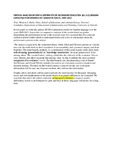| dc.contributor.author | Akala, Winston J | |
| dc.contributor.author | Sessay, Aminata | |
| dc.date.accessioned | 2015-07-14T12:30:42Z | |
| dc.date.available | 2015-07-14T12:30:42Z | |
| dc.date.issued | 2015-6-23 | |
| dc.identifier.citation | Akala, Winston J and Sessay, Aminata (20150). Critical analysis of Kenya certificate of Secondary Education (K.C.S. E) english language performance by gender in Kenya, 2009-2013. Abstracts of the 2nd AFRICE international conference held at Kenya Science Campus on 18th-23rd June 2015 | en_US |
| dc.identifier.uri | http://cees.uonbi.ac.ke/sites/default/files/cees/education/education/Akala%20and%20Amina%20Abstract.pdf | |
| dc.identifier.uri | http://hdl.handle.net/11295/87691 | |
| dc.description.abstract | In this paper we critically analyse KCSE examination results for English language over the years 2009-2013. It provides a comparative analysis of the results based on gender determining the performance trends in the selected years. It is assumed that five years are sufficient period within which to understand trends and arrive at conclusions about the performance patterns in the subject.
The analysis is guided by the evaluation theory which Alkin and Chritiere present as a family tree with the trunk built on dual foundation of accountability and systematic inquiry and three branches. The main branch, methods, is a continuation of the social inquiry trunk and it deals with obtaining ‘generalizability’ or ‘knowledge construction’. Its main proponent is Tyler among others. The second branch, valuing, establishes the vital role of the evaluator. Sriven, a key theorist and others maintain that placing value on data is perhaps the most essential component of an evaluator’s work. The third branch, use, the pioneering work of Daniel Stufflebeam and Joseph Wholey initially focused on an orientation toward evaluation and decision making. Theorists on this branch express a concern for the way evaluation information will be used and focusses on those who will use the information.
Graphs, tables and charts will be used to present the vital statistics for the paper. Emerging issues and their implications of the trends observed in gender differences are examined. We conclude that unless the school curricular /pedagogical techniques recognize gender differences, trends in performance by girls and boys in these languages will persist for a long time. | en_US |
| dc.language.iso | en | en_US |
| dc.publisher | University of Nairobi | en_US |
| dc.title | Critical analysis of Kenya certificate of Secondary Education (K.C.S. E) english language performance by gender in Kenya, 2009-2013. | en_US |
| dc.type | Presentation | en_US |
| dc.type.material | en | en_US |

